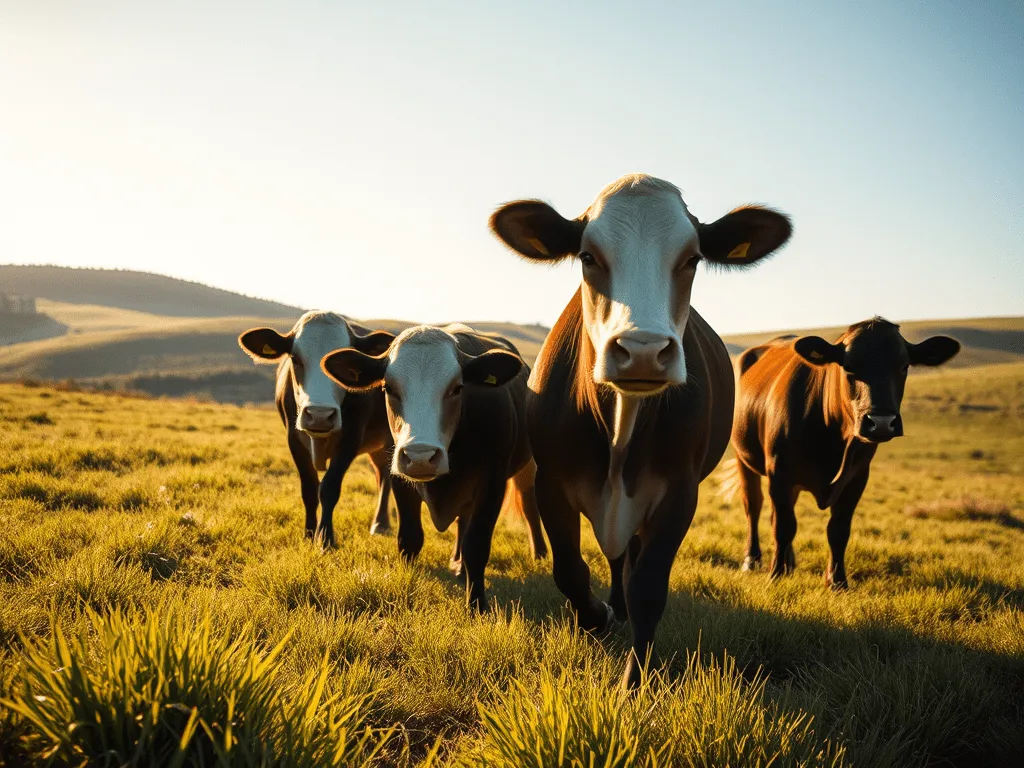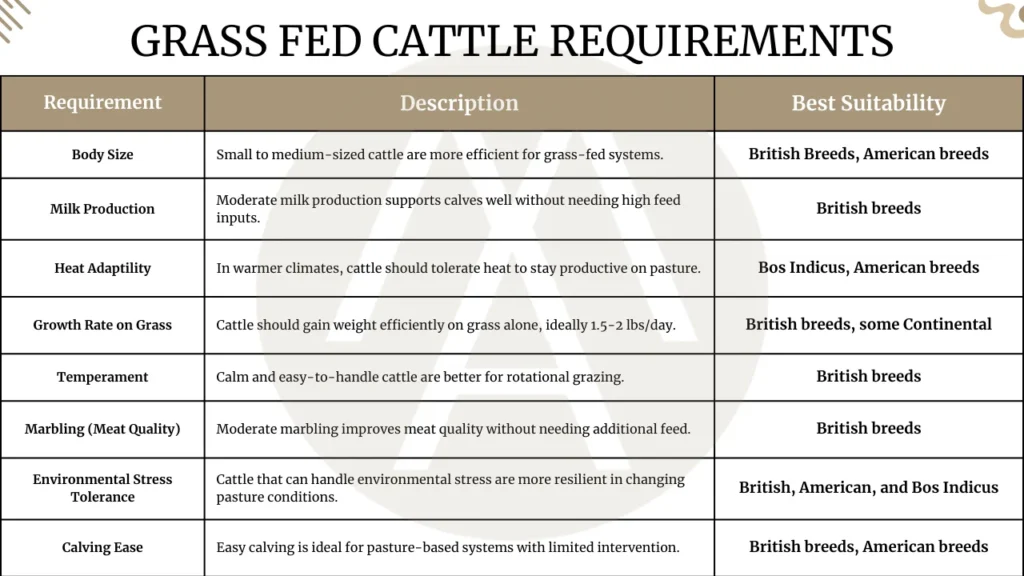Physical Address
304 North Cardinal St.
Dorchester Center, MA 02124
Physical Address
304 North Cardinal St.
Dorchester Center, MA 02124

Craving the juiciest, most tender steak? Angus beef, with its perfect marbling, delivers unbeatable flavor and melt-in-your-mouth texture. Click to discover why it's the best!
Grass-fed beef is the raging conversation in the nutrition arena. Why would anyone settle for the inferior, bland supermarket meat when they can feast on superior grass-fed options from a local specialized butcher?
When it comes to choosing the right grass-fed beef, the basics come down to choosing the right cattle. Which cattle produce the juiciest, tender grass-fed beef? Is there even a best one to pick? Let’s find out!
Grass-fed cows are allowed to graze in large pastures, where their diet consists of a variety of grasses and clover. Because their diet consists of solely grass, they tend to be a lot leaner.
It seems argumentive that these grass-fed bad boys have a lower fat percentage when it comes to fat content. This may sound great for most people, as they think animal fat is the enemy of today’s society. But animal fat is not bad when consumed with high-quality animal products.
There are two types of cholesterol: the one that’s in our food and the one that shows up in our blood panels.
Cholesterol is a type of fat that is found in nature and helps in our brain structure and function. In fact, a large amount of our brain has cholesterol in it. The levels of cholesterol in your body are determined by genetics, exercise, smoking, obesity, and of course your diet. Especially carnivores should be aware of this!
Cholesterol is the backbone of some of our crucial hormones, such as our sex hormones.
Of course, a lot of cholesterol may lead to plaque in the arteries. But that’s more the case with processed foods, an unhealthy lifestyle, and maybe some unfortunate genetics. Don’t shy away from cholesterol completely, as fulfills a crucial role in the human body. Focus on high-quality meat (grass-fed, yes), eggs, and dairy!
Now we know why grass-fed is better than grain-fed, let’s have a look at the requirements and best circumstances for grass-fed cattle for optimal meat quality.

These are the requirements based on the official American Grass-Fed Standards, combined with the ideal circumstances according to Livestock Specialist Joe C. Paschal of the Texas A&M.
Buying from AGA-certified producers will ensure your beef is raised on a pasture-raised diet, which means they graze naturally on grasses and forage.
Besides that, AGA-certified producers have to make sure they align with the standards of healthcare. This means access to clean water, shelter, and ample grazing space. These are strict guidelines and have become even more strict in today’s food society.
Make sure to download the AGA Regenerative Land Health Standards here for more info.
With these in mind, let’s have a look at the best breeds for grass-fed beef!
At #1, we have the Scottish Black Angus. What I like about this one is the ability to convert just grass and pasture into high-quality beef. The breed’s genetic predisposition toward marbling makes it ideal for grass-fed beef production.
When raised on grass, grass-fed Angus cattle retain significant intramuscular fat, increasing the tender- and juiciness of the steak.
Angus is well-known for its rich, well-marbled texture. Within the muscle, there are small “pockets” of fat. This keeps the beef most, flavorful, and tender when cooked. Obviously, it’s slightly leaner than grain-fed beef.
The beef has a rich and beefy taste and will (when properly cooked) melt like butter on your tongue. It has a natural, slightly sweet taste, making it great for EVERYONE.

Popular cuts of Angus beef are the ribeye, sirloin, T-bone, and New York strip.
Our second best grass-fed beef cattle is the Hereford cattle. These are easily recognizable by their white faces and red bodies. What I like about Herefords is that they can, like Angus, convert grass into high-quality beef. They are adaptable to different climates and are excellent for pasture-based systems.
They tend to produce beef with good marbling, which is a key factor for tenderness and juiciness.
Hereford beef has a tender texture. It may not be on the same levels of marbling as the Angus, but it still provides a juicy eating experience when cooked properly. The mild flavor of the Hereford beef makes it easily combinable in different meals.
The beef has a mild, rich, and tender texture. It has a slightly less intense flavor than the Angus but is still a great option for grilling or roasting.
Chuck roast, ribeye, and flank steaks are popular from grass-fed Hereford cattle, offering tenderness and a well-rounded flavor.
My 3rd best cattle for some juicy grass-fed beef is the Red Devon cattle. What I like about these is that they require minimal supplemental feeding and are well-known to thrive on various pastures. Also, the Red Devon cattle are highly efficient in their grass-to-high-quality beef conversion.
Red Devon beef is known for its fine texture, and rich, deep color. It is slightly leaner than the Angus or the Hereford, but that doesn’t mean it’s not tender or flavorful. The meat has a fine grain and is highly tender, thanks to its efficient grass-to-beef conversion.
Red Devon beef has a deep, earthy. flavor with natural tones of sweetness and umami (savory taste, like tomatoes). The marbling, although it’s not the strongest on this list, still provides a buttery, juicy finish. Recommended is to cook it to medium or medium-rare for optimal tenderness.
Ribeye, sirloin, brisket, flank steak, and chuck roast are popular cuts from Red Devon cattle.
A common question, and one that’s hard to answer. It depends on a variety of factors, such as flavor preferences, marbling, quality of the chef, and more.
Let’s compare our #1 and #2 for some extra clarity on the best cattle for grass-fed beef!

If taste and richness are your primary considerations, Angus is likely the “better” choice due to its more intense flavor and tenderness from marbling. However, if you’re prioritizing leaner, more nutritious beef with less fat and calories, Hereford might be considered “better” from a health standpoint.
For a more indulgent experience, go with Angus; for a leaner, healthier option, Hereford is a solid choice.
The differences aren’t significant.
Oh man, if only you knew how today’s supermarket’s meat is produced. A lot of hormones, drugs, and even more antibiotics. All of this is to accelerate their growth, maximizing the revenue for the farmers.
When it comes to choosing the right cattle, we’re looking for meat that is impacted the least by humans. We, as humans, interfere with the cycle of nature, impacting our own health indirectly.
Whenever we eat beef from grain-fed cows, we are practically eating cows that are dying from the same diseases as we are. Today’s nutrition is filled with highly processed, low-quality products. Those same products are fed to the cows, indirectly affecting our own health and well-being.
In short, grain-fed cows are placed in small pens and fed a diet of soy and corn-based grains, whereas grass-fed cows are allowed to graze on grass in large compounds. Decide for yourself which one is better for your health…
In conclusion, grass-fed beef offers a healthier, more flavorful alternative to grain-fed options, making it a preferred choice for many consumers who prioritize quality and nutrition. Breeds like Angus, Hereford, and Red Devon excel in producing high-quality meat, each with unique characteristics that cater to different taste preferences and culinary uses.
Angus stands out for its rich marbling and tenderness, which can significantly enhance the dining experience. The marbling in Angus cuts allows for a juicy and flavorful bite that is hard to match.
On the other hand, Hereford beef provides a leaner, milder flavor profile that appeals to those who prefer a less intense taste. This breed is known for producing meat that is not only healthier but also used in various culinary preparations. Hereford beef can be an excellent choice for dishes where the meat is not the main flavor focus, allowing other ingredients to shine.
Red Devon, though slightly leaner than its Angus counterpart, offers a tender, earthy taste that many find appealing. This breed is often enjoyed by those who appreciate a more nuanced flavor. Red Devon beef can lend itself beautifully to slow-cooked dishes, barbecues, or roasts, providing a satisfying and wholesome meal.
Ultimately, choosing grass-fed beef represents a commitment to healthier eating. It is a cleaner, more natural choice that supports better health while providing superior taste and texture compared to conventionally raised beef.
The best cattle breed for grass-fed beef depends on your preferences for flavor, tenderness, and fat content. However, Angus is often considered the top choice due to its superior marbling, which enhances flavor and juiciness, making it ideal for grass-fed beef production.
Hereford is also a strong contender, producing leaner beef with a tender texture and mild flavor.
Red Devon, though slightly leaner, offers a rich, earthy taste and high tenderness, making it another excellent option. Ultimately, Angus tends to be favored for its flavor and marbling, but Hereford and Red Devon offer great alternatives for leaner, more nutritious beef.
The “best producing” cow depends on whether you’re focused on milk or beef:
The best breed varies based on your production goals and environment.
The breed of cattle known for the best-tasting meat is Angus. Its marbling (fat within the muscle) enhances flavor, tenderness, and juiciness, making it a favorite for high-quality beef.
Other breeds like Wagyu are also prized for their rich, buttery taste due to exceptional marbling, but Angus is widely regarded as one of the top choices for delicious, flavorful beef.